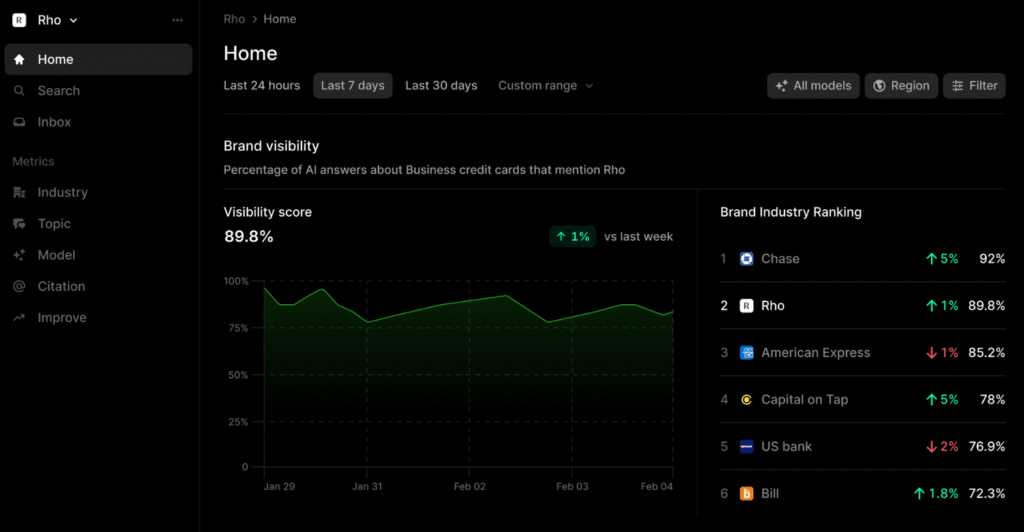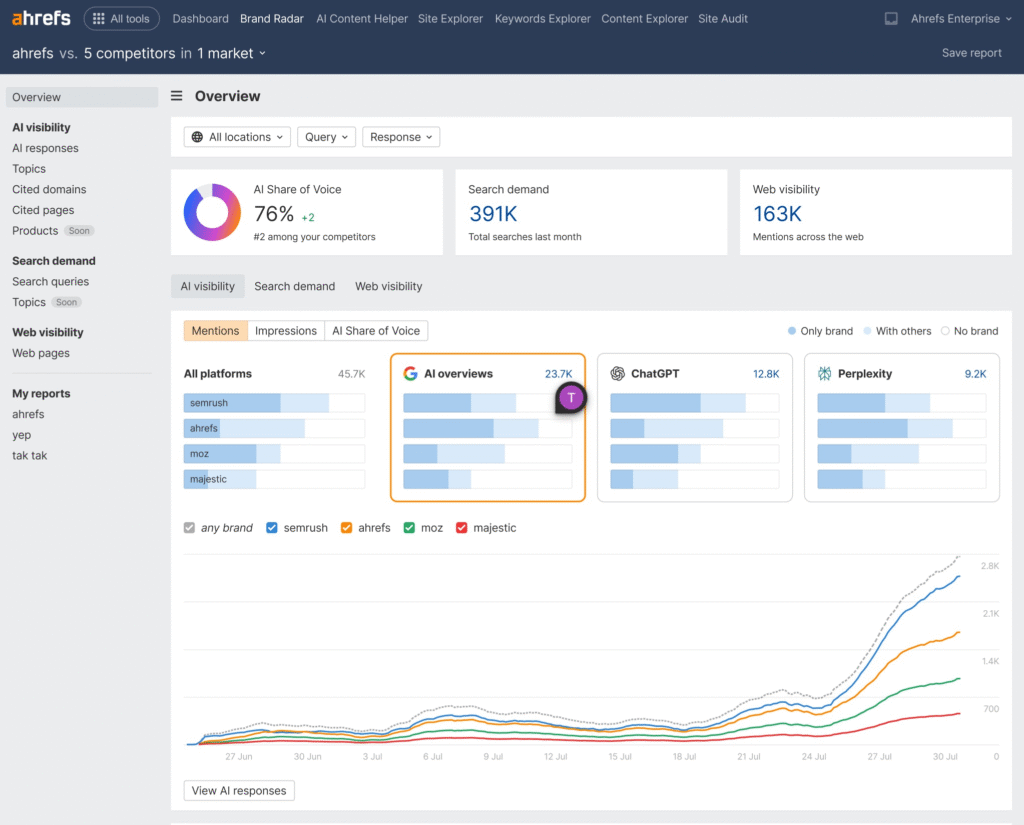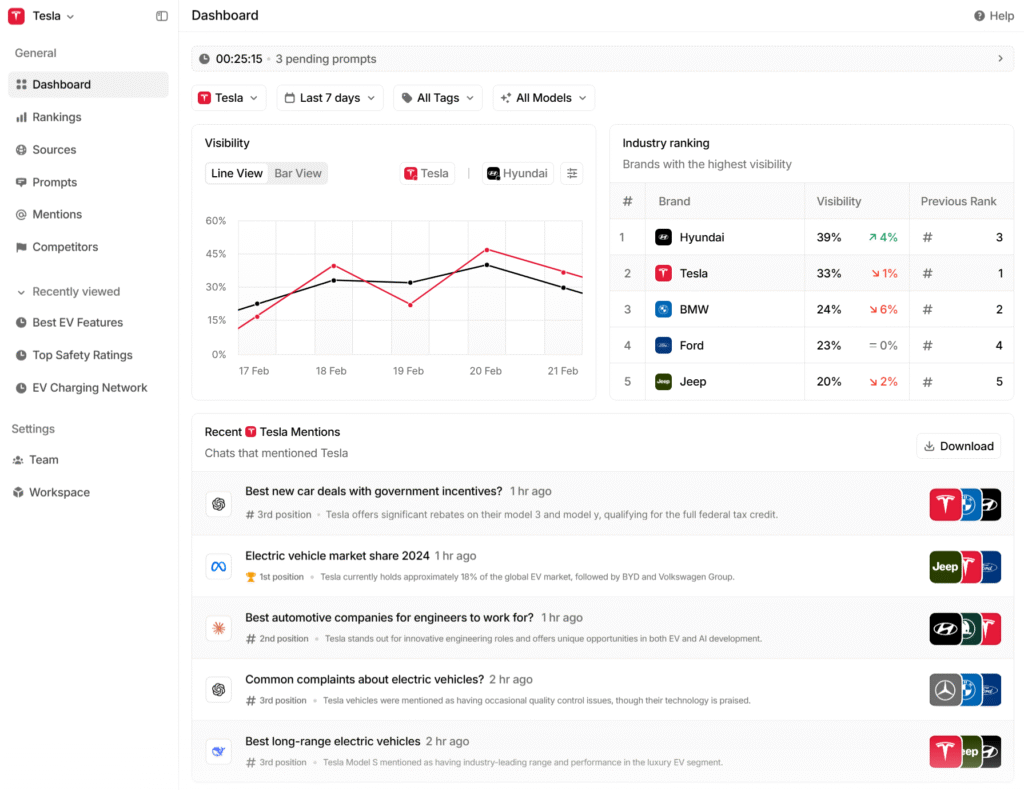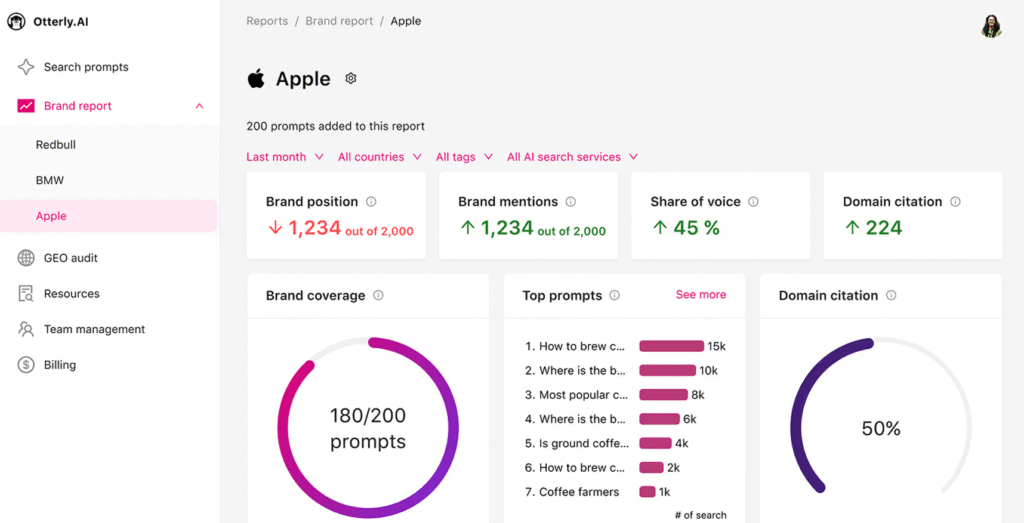Let’s cut through the noise. Every week, I see another “revolutionary” AI visibility tool launch with grand promises and inflated marketing claims. Meanwhile, SEOs and marketers are drowning in demos, confused by inconsistent data, and throwing money at solutions that may not even work.
I’ve spent months testing these platforms, sitting through countless sales pitches, and analyzing real performance data. Here’s what you actually need to know about AI visibility optimization tools in 2025—without the vendor BS.
Why AI Visibility Tools Are Essential (The Hard Truth About AI Search)

First, let’s be honest about what we’re dealing with. AI search isn’t some distant future—it’s happening now. ChatGPT hit 2.6 billion visits in August 2024. Stack Overflow’s search traffic is down 50% as developers switch to AI assistants. Google’s AI Overviews have more than doubled since March.
But here’s what the tool vendors won’t tell you: AI visibility is fundamentally different from traditional SEO. Your keyword rankings don’t matter if ChatGPT never mentions your brand. Your backlink profile is irrelevant if Perplexity cites your competitors instead.
This isn’t about optimizing for another search engine—it’s about understanding how AI systems interpret, synthesize, and cite information. And yes, you need tools to track this stuff because manual checking is completely inadequate.
Why Most AI Visibility Tools Are Overhyped
Before we dive into specific tools, let me save you some time and money. Most AI visibility platforms suffer from the same fundamental problems:
Inconsistent Data Collection: Some tools use APIs, others scrape outputs, and many rely on third-party data. The result? Wildly different numbers for the same queries.
Cherry-Picked Metrics: “AI visibility score” sounds impressive until you realize it’s a made-up metric with no industry standard.
Probabilistic Limitations: AI outputs change based on timing, phrasing, and user behavior. Many tools ignore this reality.
Overpriced Enterprise Theater: Just because a tool costs $3,000/month doesn’t mean it’s 10x better than a $300 solution.
Now, let’s look at what actually works.
Top 10 AI Visibility Tools Ranked by Real Value (2025 Analysis)
Comparison Table: What You’re Actually Getting
| Tool | Real Price | Actually Covers | What It’s Good For | Skip If… |
|---|---|---|---|---|
| Profound | Enterprise only | ChatGPT, Perplexity, Gemini, AI Overviews | Enterprise compliance, real-time data | You’re not Fortune 500 |
| Ahrefs Brand Radar | $199/month add-on | ChatGPT, Perplexity, Gemini, AI Overviews, Copilot | SEO integration, trusted data | You don’t use Ahrefs |
| Peec.ai | €89/month | ChatGPT, Perplexity, Claude, Google AI Overviews | Brand vs. citation tracking, competitive intel | You need basic monitoring |
| Otterly.AI | $29-$989/month | ChatGPT, Google AI Overviews, Perplexity, Gemini, Copilot | Link citation tracking, prompt research | You want simple dashboards |
| Scrunch AI | $300/month | ChatGPT, Gemini, Perplexity, Meta AI | Brand sentiment, customer journey mapping | You’re budget-conscious |
| AthenaHQ | $1,250/month | ChatGPT, Claude, Perplexity, Gemini, Copilot | AI-generated recommendations | You’re not VC-funded |
| Writesonic GEO | $16/month | ChatGPT, Perplexity, Claude, Google AI Overviews | Content optimization integration | You want pure monitoring |
| Knowatoa | $49/month | ChatGPT, Claude, Perplexity, Meta AI, Google AI | Crawlability analysis, brand accuracy | You need enterprise features |
| SE Ranking AI | $99/month | ChatGPT, Gemini, Perplexity, Google AI | Traditional SEO integration | You don’t use SE Ranking |
| Rankscale | €20/month | ChatGPT, Perplexity, AI Overviews | Budget-friendly comprehensive analysis | You need proven reliability |
AI Visibility Tool Deep Dive: What Actually Works
Profound: The Enterprise AI Visibility Solution

Website: https://www.tryprofound.com
What they say: “Enterprise-grade AI visibility optimization platform.”
What it actually is: The only tool with SOC 2 Type II compliance and proper enterprise security. Ramp became the 5th most visible fintech brand globally using Profound’s insights—that’s not marketing fluff; that’s a real case study with measurable results.
The catch: Custom pricing that starts at “If you have to ask, you can’t afford it.” Currently invite-only because they’re focused on Fortune 500 clients who can actually use their advanced features.
Bottom line: If you’re a large enterprise with compliance requirements, this is your only real AI visibility option. Everyone else is wasting time on demos.
Ahrefs Brand Radar: The SEO Professional’s AI Tool

Website: https://ahrefs.com/brand-radar
What they say: “Track your brand in AI search.”
What it actually is: The most credible entry into AI visibility tracking, backed by Ahrefs’ established data infrastructure. They analyzed 75,000 brands to identify what actually correlates with AI visibility (spoiler: it’s branded search volume, not backlinks).
The reality: It’s an add-on to existing Ahrefs plans at $199/month per AI platform. No inflated enterprise pricing, no made-up metrics—just solid data from a company that knows search.
Why it matters: If you’re already using Ahrefs for SEO, this AI visibility tool is a no-brainer. The data quality is consistent with their other tools, and they’re not trying to reinvent analytics—they’re extending proven methodologies to AI search.
Peec.ai: The Fastest-Growing AI Visibility Platform

Website: https://peec.ai
What they say: “AI search analytics for marketing teams.”
What it actually is: The first tool to properly distinguish between brand mentions and source citations—a crucial difference that most platforms ignore. They raised €7M in five months and are generating €650K annually while adding €80K every week.
The data: Perfect 5.0 rating on Slashdot with reviews calling it “The Best Tool to Track AI Chat Visibility.” That’s not paid promotion—that’s organic user feedback.
Who should care: Mid-market companies that want accurate AI visibility tracking without enterprise pricing. At €89/month, it’s positioned perfectly between basic AI tools and overpriced enterprise solutions.
Otterly.AI: The Comprehensive AI Search Tool

Website: https://otterly.ai
What they say: “Your platform to rank higher in AI searches.”
What it actually is: The most comprehensive platform coverage with transparent pricing. They track link citations automatically and provide conversational keyword research—features that most competitors charge extra for.
The pricing reality: $29/month gets you started, but you’ll probably need the $189 Standard plan for meaningful insights. The $989 Pro plan is for agencies managing multiple clients.
Why it works: They’re not trying to be everything to everyone. They focus on AI visibility tracking and do it well. If you’re an SEO who needs to understand which pages get cited by AI platforms, this is your AI tool.
Scrunch AI: The Brand Manager’s AI Visibility Platform
Website: https://scrunchai.com
What they say: “Brand monitoring and optimization for the AI era.”
What it actually is: the most sophisticated brand sentiment analysis available. They raised $4M from Mayfield and signed enterprise clients like Lenovo—not because of marketing, but because they solve real brand management problems.
The enterprise focus: At $300/month, they’re targeting marketing teams who need to understand customer journey mapping and competitive positioning in AI responses.
When it’s worth it: If brand perception and competitive intelligence are critical to your business, the price is justified for this AI visibility tool. If you just need basic tracking, it’s overkill.
The Budget Reality Check
Here’s what you should actually budget for AI visibility tracking:
| Small Businesses ($20-99/month): | Mid-Market ($99-300/month): | Enterprise ($300+/month): |
| Rankscale at €20/month for basic monitoring | Ahrefs Brand Radar at $99/month if you use Ahrefs | Scrunch AI at $300/month for brand sentiment |
| Writesonic GEO at $16/month if you need content integration | Peec.ai at €89/month for competitive intelligence | AthenaHQ at $1,250/month if you’re VC-funded |
| Knowatoa at $49/month for crawlability analysis | Otterly.AI Standard at $189/month for comprehensive tracking | Profound for custom enterprise needs |
AI Tools to Skip (And Why These AI Visibility Platforms Don’t Work)
AthenaHQ: Y Combinator pedigree doesn’t justify $1,250/month for this AI visibility tool unless you’re burning VC money. The features don’t match the premium pricing.
SE Ranking AI: Only makes sense if you’re already an SE Ranking customer. The AI visibility features feel like an afterthought to their main SEO platform.
Most “emerging” AI tools: Every month brings new AI visibility platforms promising revolutionary features. Most disappear within a year. Stick with AI tools that have actual traction and funding.
What The AI Visibility Data Actually Shows
Ahrefs analyzed 75,000 brands and found the strongest correlations with AI visibility:
- Branded search volume (0.392 correlation): The strongest predictor
- Domain mentions across the web: More important than backlinks
- Content authority signals: Quality trumps quantity
- Brand recognition factors: AI systems favor established entities
This research confirms what experienced SEOs suspected: AI visibility isn’t about gaming new algorithms—it’s about building genuine brand authority and recognition.
AI Visibility Tool Implementation: The Right Way to Start
Most companies approach AI visibility tool selection entirely wrong. They:
- Shop for AI tools before understanding their needs
- Get distracted by fancy dashboards and custom AI visibility metrics
- Expect immediate ROI from AI brand awareness initiatives
- Ignore the fact that AI traffic is still minimal (about 0.1% of total traffic)
Here’s the right approach to choosing AI visibility tools:
Start with one AI tool that matches your budget and current tool stack. If you use Ahrefs, get Brand Radar. If you’re budget-conscious, try Peec.ai or Otterly.AI. If you’re an enterprise, evaluate Profound.
Focus on competitive intelligence, not vanity AI visibility metrics. Understanding how competitors appear in AI responses is more valuable than tracking your own “AI visibility score.”
Treat this as brand building, not performance marketing. AI visibility is a long-term play that supports overall brand awareness, not a quick traffic grab.
AI Tools That Are Actually Innovating AI Visibility
Profound: Real-time AI search volume insights—the first AI visibility tool to show what people are actually asking AI platforms.
Ahrefs Brand Radar: A research-backed approach with 25+ million AI Overviews analyzed. They’re applying established search intelligence to AI platforms instead of making up new AI visibility metrics.
Peec.ai: Proper distinction between brand mentions and source citations in their AI tool. This nuance matters more than most AI visibility vendors realize.
Scrunch AI: Customer journey mapping in AI contexts. They understand that AI search changes the entire discovery process, not just individual queries.
What’s Coming Next for AI Visibility Tools
The AI visibility tool market is consolidating fast. Expect:
Acquisition activity: Larger SEO platforms will acquire specialist AI tools rather than building from scratch.
Price pressure: Enterprise tools charging $3,000/month can’t justify 15x premium over mid-market solutions with similar features.
Feature convergence: Basic AI monitoring will become a standard feature. Differentiation will come from integration quality and actionable insights.
Data standardization: The current chaos of incompatible metrics will resolve as the market matures.
The Bottom Line
Stop overthinking this. AI visibility tracking is important, but it’s not rocket science. Most businesses need:
- Basic competitive intelligence to understand how competitors appear in AI responses
- Brand mention tracking to identify inaccuracies or missed opportunities
- Citation analysis to see which content gets referenced by AI platforms
You don’t need enterprise-grade dashboards, custom integrations, or proprietary algorithms. You need reliable data and actionable insights.
My recommendations:
If you use Ahrefs, get Brand Radar. It’s the most credible option with proven data quality.
If you want comprehensive coverage, Otter.ai or Peec.ai offer the best value for most businesses.
If the budget is tight, start with Rankscale or Writesonic GEO to understand the basics.
If you’re an enterprise, evaluate Profound seriously—it’s the only tool built for your compliance and security requirements.
If you’re focused on brand management, Scrunch AI provides deeper insights into brand perception and competitive positioning.
The AI search revolution is real, but the tool market is full of noise. Focus on platforms with proven traction, transparent pricing, and features that match your actual needs—not your wishlist.
And remember: the best AI visibility tool is the one you’ll actually use consistently to improve your brand’s presence in AI-driven search results. Everything else is just expensive dashboard theater.
Is a senior SEO expert with over a decade of experience dominating the digital marketing battlefield. Since 2023, I’ve been riding the AI wave. Since 2024, I have started to work with the SEO Bazooka Blog.

Leave a Reply